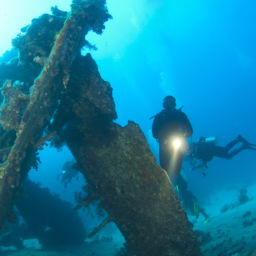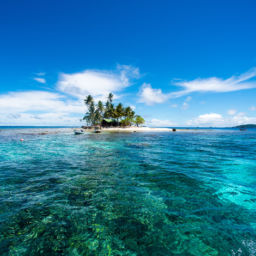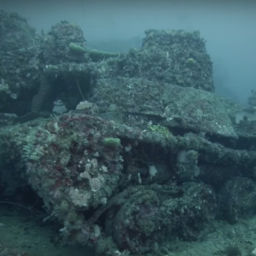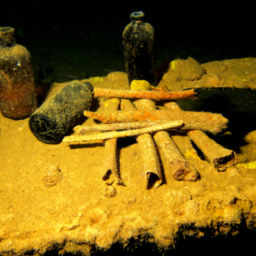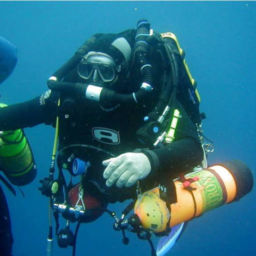In Micronesia: Diving the Ghost Fleet of Chuuk Lagoon
Nearly 70 years ago during World War II, the United States launched a combination of air strikes, submarine attacks and surface ship actions upon a major Japanese logistical stronghold in the Pacific that was known, at that time, as Truk Lagoon.
Dubbed Operation Hailstone, the two-day attack decimated the Japanese fleet that was staged there. Three Japanese light cruisers, four destroyers, three auxiliary cruisers, two submarine tenders, an aircraft transport, three smaller warships and 32 merchant ships sank during the attack. In addition, the American operation destroyed more than 250 Japanese aircraft. The U.S. also lost 25 aircraft. Today, what’s become known as the Ghost Fleet of Chuuk Lagoon counts some 60 ships and 275 aircraft within a watery graveyard surrounded by beautiful tropical islands. And among the fascinating wrecks you can find here is the I-169 Shinohara, a Japanese submarine that was involved in the attack on Pearl Harbor.
By now, you might be wondering what’s with this little history lesson. The answer? Wreck diving, of course. Scattered around the islands of Chuuk in Micronesia are over 300 wrecks, many of which rest in less than 50 feet of crystal clear and perfectly warm and calm water. The Ghost Fleet, as you might imagine, is a wreck diver’s paradise.
Because the ships and planes sank in the midst of their operational tasks, many of them still contain most of the equipment that was aboard when they went down. Divers can easily see gas masks, torpedoes, mines, munitions, radios, bulldozers, railroad cars, tanks – even human remains – resting on the decks, inside the hulls, and littered around these wrecks that are now part of an underwater museum and marine sanctuary.
The lagoon is 40 miles wide and 300 feet deep with warm water and very little current. Breathtaking coral gardens have overtaken the wrecks. They’re now home to hundreds of exotic fish and large animals, too, including mantas, sharks and turtles.
While there are hundred of wrecks in the area, it’s important to know which ones are diveable. Since many of the lagoon’s ships and planes met their demise while still full of oil and fuel, some of them continue to leak fluids into the waters. This can compromise not only visibility but safety, too. Indeed, all of the wrecks here are not created equal, so it’s worth knowing which ones stand out.
Best of the Best
With masts covered in crimson sponges, the Hoki Maru is a sight to behold. Its hull is full of cargo that includes everything from bombs to sake bottles. The wreck of the Fujikawa Maru, too, should be on every diver’s list. Soft corals, sea anemones and fans blanket the coral-encrusted bow and gun. The galley, staterooms, baths and pilothouse are all easily accessible, making this dive among the lagoon’s best. The San Francisco Maru is one of the deepest wrecks in the lagoon. One of the highlights for divers (and photographers) is the chance to see the tanks sitting on the main deck and the trucks resting in the ship’s hold.
Shallow enough for snorkelers, both the Susuki Destroyer and the Sankisan Maru have dense and colorful coral growth. Relics scattered about are easily visible. One of the more beautiful ships in the graveyard is the Shinkoku Maru. Here, thousands of fish swirl atop overgrown corals and sponges that blanket the wreck’s exposed structure with luxurious washes of color. The galley and the bridge are accessible here, too, and divers also enjoy seeing the collection of recovered dishes and gear on display.
Climate
With topside temperatures averaging between 76 and 87 degrees Fahrenheit year round, there really isn’t a bad time to visit Chuuk. From July to November, however, the tropical humidity can be oppressive. January, February and March are the most ideal times to visit for calmer and less humid weather.
On Land
You came all this way, so you might as well see some of the area’s terrestrial highlights, too. And the day before you fly home is always a good time to dry out on a land tour. Towering over the lush island vegetation, Tonachau Mountain is the highest point in Chuuk. It has a long religious and mythological history for the people here. A pool at the bottom of a nearby waterfall is a scenic spot to cool off. Be sure to look up to see petroglyphs etched into the basalt rock just above the falls.
Sapuk Lighthouse, built in the 1930s by the Japanese, provides the only panoramic view of the entire lagoon. Even a leisurely walk through the villages of the Chuuk Islands is educational. Locals cook fresh fish over open-hearth fires, and people take part in traditional activities like weaving and carving. These are the backbone of a trade that helps the population sustain the island life.
In short, if wreck diving has ever caught your fancy, then the wrecks of Chuuk Lagoon should be at the top of your bucket list. The haunting history here is more than enough to keep any diver interested. And some divers even claim to have seen ghosts on the lagoon’s wrecks. I don’t know about you, but I, for one, would love to go investigate that for myself.


